Συντεχνία vs Συντεχνίας
Πάρε μέρος στον πόλεμο!
Η συντεχνία σου πολεμά ενάντια σε άλλες για επιβίωση και δύναμη. Ο στόχος σου είναι να επεκτείνεις την περιοχή της συντεχνίας σου και να την κρατήσεις, για να ανέβει το επίπεδο της συντεχνίας σου και να κερδίσεις μπόνους και δόξα για όλα της τα μέλη.
Καθημερινά στη ΣεΣ η συντεχνία σου πρέπει να κατακτά νέους τομείς και να υπερασπίζεται αυτούς που έχει ήδη στην κατοχή της. Στο τέλος κάθε ημέρας (όταν τελειώνει το χρονόμετρο της αντίστροφης μέτρηση), η εμπειρία της συντεχνίας υπολογίζεται σύμφωνα με την περιοχή που έχει στην κατοχή της και αυτή η εμπειρία συμβάλει στο επίπεδο της συντεχνίας. Ανέβασε το επίπεδο της συντεχνίας σου για να κερδίσεις καλύτερες ανταμοιβές!
Για να μπεις στη δράση, θα πρέπει να είσαι μέλος μιας συντεχνίας. Δεν έχει σημασία το μέγεθος της συντεχνίας, αν είσαι στην Εποχή του Σιδήρου ή πιο πάνω, μπορείς να πάρεις μέρος. Η μάχη ΣεΣ δίνει επίσης πόντους μάχης , έτσι δε χρειάζεται να επιλέξεις ανάμεσα στους πύργους ή τη ΣεΣ.
Η ΣεΣ είναι μόνο διαθέσιμη στην έκδοση για υπολογιστές
Για να έχεις πρόσβαση στη ΣεΣ, πάτησε το εικονίδιο, δεξιά κάτω στο μενού:

Χάρτης Ηπείρων Συντεχνίας
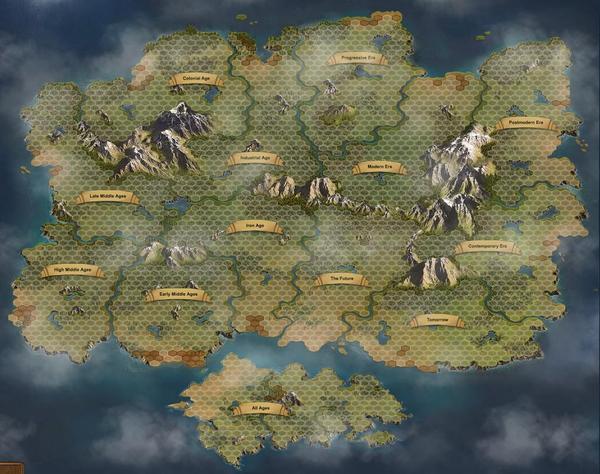
Όλη η δράση γίνεται μέσα από το Χάρτη Ηπείρων ΣεΣ, ο οποίος είναι ένας ιδιαίτερος χάρτης σχεδιασμένος για μάχες και πόλεμο ανάμεσα στις συντεχνίες. Ο χάρτης χωρίζεται σε επαρχίες, οι οποίες όπως μπορείς να δεις τα σύνορα που τις χωρίζουν είναι ποτάμια και βουνά. Όλες οι επαρχίες αντιπροσωπεύουν μία εποχή, εκτός από μία - στο κάτω μέρος η οποία είναι μία ιδιαίτερη "Όλων των Εποχών" επαρχία.
Ο χάρτης ηπείρων ΣεΣ σου επιτρέπει να έχεις μια γρήγορη προεπισκόπηση από την επιρροή της συντεχνίας σου σε διαφορετικές επαρχίες κι επίσης λειτουργεί σαν σημείο πρόσβασης σε αυτές τις επαρχίες, όπου θα πολεμήσει η συντεχνία σου. Στην εικόνα παρακάτω, μπορείς να δεις της περιοχή επιρροής της συντεχνίας σου με έντονο πράσινο, και την εχθρική περιοχή με κόκκινο. Οι πορτοκαλί περιοχές δείχνουν την περιοχή που δεν ανήκει σε κανένα παίκτη, στις οποίες δεν έχουν επεκταθεί ακόμα οι συντεχνίες των παικτών.
Η συντεχνία σου μπορεί να πολεμήσει σε μία μόνο επαρχία, ή σε όλες ... η επιλογή είναι δική σου! Ωστόσο, όταν πολεμάς σε μία από τις επαρχίες συγκεκριμένης εποχής, μπορείς να πολεμήσεις μόνο χρησιμοποιώντας μονάδες και αγαθά από την ίδια εποχή της επαρχίας που πολεμάς... έτσι, για παράδειγμα, στο χάρτη της Εποχής του Σιδήρου, μπορείς να χρησιμοποιήσεις μόνο μονάδες και αγαθά από την Εποχή του Σιδήρου.
Επαρχία Όλων των Εποχών
Στο κάτω μέρος του χάρτη υπάρχει μια μικρή ιδιαίτερη επαρχία "Όλων των Εποχών". Σε αυτή την επαρχία μπορείς να χρησιμοποιήσεις μονάδες από οποιαδήποτε εποχή στις μάχες σου. Δε μπορείς να χρησιμοποιήσεις αγαθά σε αυτό το χάρτη - το κόστος πολιορκίας, όπως και το κόστος τοποθέτησης αμυντικών στρατευμάτων, μπορούν να πληρωθούν μόνο με μετάλλια.
Επαρχίες
Οι μάχες γίνονται στον χάρτη επαρχίας. Με τη βοήθεια των συντέχνων σου τοποθετείς πολιορκία σε ένα τομέα και μετά του επιτίθεσαι.
Τομείς
Ο χάρτης επαρχίας αποτελείται από τομείς, οι οποίοι αντιπροσωπεύονται από εξάγωνα. Είναι δουλειά της συντεχνίας σου να κατακτήσει αυτούς τους τομείς - και να τους υπερασπίσει από εισβολείς - για να επεκτείνετε την περιοχή σας. Υπάρχουν δύο στάδια στην κατάκτηση ενός τομέα: πρώτα τοποθετείς πολιορκία και μετά πρέπει να επιτεθείς!
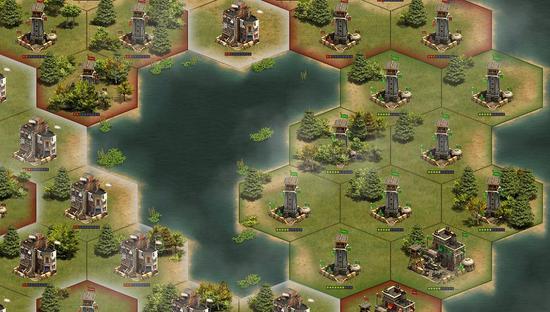
Οι τομείς χωρίζονται με χρώματα σύμφωνα με τον ιδιοκτήτη τους:
- Κόκκινο - Εχθρική συντεχνία
- Πράσινο - Η Συντεχνία σου
- Άσπρο - Ουδέτεροι (NPCs).
Ζώνη Προσγείωσης
Όταν ανοίξεις τον χάρτη επαρχιών Συντεχνίας για μια εποχή, θα παρατηρήσεις ότι μέρος του χάρτη είναι σκούρο, που δείχνει ότι είναι ανεξερεύνητη περιοχή που δεν έχει διεκδικηθεί ακόμα. Η ενεργή περιοχή είναι αυτή που μπορείς να τοποθετήσεις τον πρώτο στρατό σου και να ιδρύσεις το αρχηγείο της Συντεχνίας σου.
Σε ποιον τομέα να κάνω επίθεση?
Όταν μπεις αρχικά σε ένα χάρτη επαρχίας, έχεις τη δυνατότητα να τοποθετήσεις ένα στρατό πολιορκίας σε οποιοδήποτε από τους τομείς στη ζώνη προσγείωσης (λευκή περιοχή), ή σε έναν τομέα δίπλα σε ποτάμι ή δίπλα σε περιοχή άλλης συντεχνίας. Τα υπόλοιπα εξάγωνα ακόμα ανήκουν στους NPCs, αλλά μπορούν μόνο να δεχθούν επίθεση αν έχεις τον έλεγχο ενός παρακείμενο εξαγώνου.
Κατάσταση Τομέα
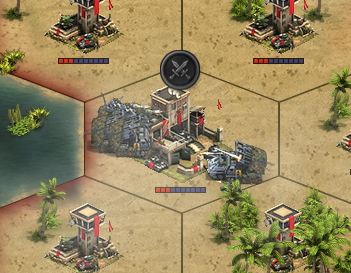
Μπορείς να δεις στο χάρτη παραπάνω αν ένας τομέας είναι σε κατάσταση πολιορκίας, καθώς έχει ένα εικονίδιο με σταυρωμένα σπαθιά πάνω του. Ένα εικονίδιο ασπίδας πάνω από έναν τομέα σημαίνει ότι αυτός ο τομέας προστατεύεται, καθώς έχει κατακτηθεί πρόσφατα και δεν μπορεί να δεχθεί επίθεση για την ώρα. Οι προστατευμένοι τομείς επίσης δε μετρούν για επίθεση και τοποθεσία πολιορκητικού στρατού. Αυτό σημαίνει ότι αν έχεις μόνο έναν προστατευμένο τομέα δίπλα από έναν εχθρικό τομέα που θέλεις να επιτεθείς, θα πρέπει να περιμένεις μέχρι να λήξει η προστασία από τον τομέα σου πριν μπορέσεις να αναπτύξεις πολιορκητικό στρατό εκεί.
Ιστορικό Γεγονότων
Το ιστορικό γεγονότων καταγράφει τις δράσεις που έχουν γίνει από τα μέλη της συντεχνίας σου και των εχθρικών συντεχνιών. Μπορείς να έχεις πρόσβαση σε αυτό από τον χάρτη επαρχίας πατώντας στο κουμπί του ιστορικού γεγονότων στο μενού στην κάτω αριστερή πλευρά της οθόνης.
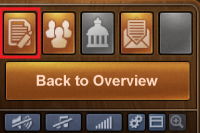
Υπάρχουν τρεις διαφορετικές καρτέλες στο ιστορικό:
- Σημαντικά γεγονότα
- Δράσεις της συντεχνίας σου
- Δράσεις της εχθρικής συντεχνίας
Πατώντας πάνω σε μία καρτέλα στο ιστορικό γεγονότων θα δεις μια λίστα από τα πρόσφατα γεγονότα και πότε έγινε το κάθε ένα. Πατώντας πάνω σε μία καταγραφή θα επικεντρωθεί ο χάρτης σε αυτή την περιοχή.
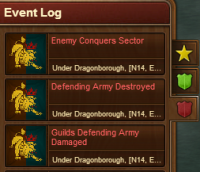
Τομείς
Μπορείς να δεις πληροφορίες για έναν τομέα βάζοντας το ποντίκι πάνω από αυτόν στο χάρτη επαρχιών. Όταν ελέγχεις έναν τομέα, αποκτάς "δύναμη" την οποία μπορείς να δεις στις πληροφορίες του τομέα. Διαφορετικοί τομείς παρέχουν περισσότερη ή λιγότερη δύναμη, αφού κερδίζεις δύναμη, μετατρέπεται σε πόντους εμπειρίας για τη συντεχνία σου, που χρησιμοποιούνται για να ανέβει επίπεδο η συντεχνία σου.
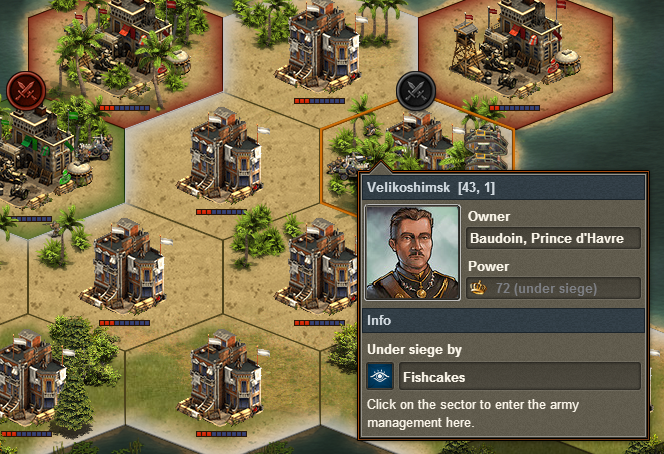
Το λευκό χρώμα ενός εξαγώνου στην εικόνα δείχνει ότι αυτός ο τομέας ελέγχεται από NPC. Μπορείς επίσης να δεις τις συντεταγμένες της συντεχνίας (βολικό για στρατηγικές επικοινωνίας με τους συντέχνους σου!), δύναμη και αν ο τομέας είναι υπό πολιορκία, επίσης εμφανίζονται πληροφορίες σχετικά με τον πολιορκητή.
Sector options
When you click on a sector, the options displayed depend on whether the sector belongs to your guild, if an enemy guild controls it, or an NPC (in which case no options are shown). Pictured is an example of sector options for one of your own guild's sectors.
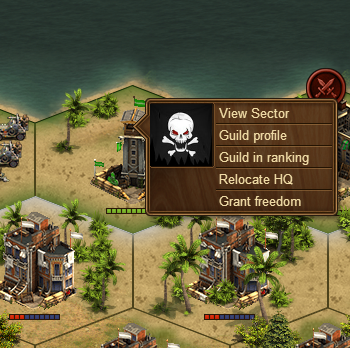
Clicking the Profile option will take you to your guild's profile, and Guild in Ranking will bring up the Guild Ranking screen.
Relocate HQ
Every day, your support pool bonus is applied first to your HQ, which gets the strongest bonus, and then to adjacent sectors, spiraling outwards. This makes your HQ a strategic center which your guild may wish to relocate on occasion. Clicking the Relocate HQ button will move your HQ to the chosen location, but this can only be done once per day. Note that the support pool bonuses for sectors will not change until the next daily calculation.
Grant freedom
If a sector is no longer strategically useful for your guild, you can choose to grant it freedom. This will result in the sector becoming controlled by an NPC, and a goods payout will be made to your guild treasury, which is based on the territory owned by your guild, and the number of siege armies it has placed. Remember that each "trusted" player can only grant freedom to four sectors per day.
Conquering a sector
Enter an enemy sector by clicking its hex and selecting the "view sector" option (skipping the "view sector" option when entering an NPC-controlled sector), and this will take you to the army management screen. At the top right of the screen is a space where you can deploy armies to the sector. There are two possible options for deploying armies: siege army (if you don't own the sector), and defense armies (if you do). As we are trying to conquer the sector, in this case you would want to deploy a siege army.
Deploying a siege army
Before you can begin attacking, you first need to stake a claim to the sector you want to conquer. Deploying your guild's first siege army costs goods, and the amount required which is shown when you hover over the deployment button.
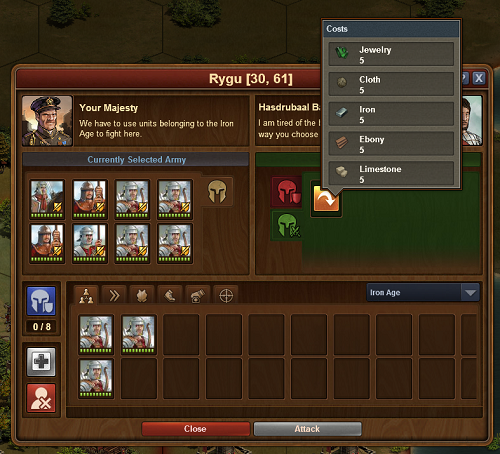
Attacking a sector
Once you have laid claim to the sector you want, and deployed your siege army, the attacks can begin to conquer it! One single attack is unlikely to be enough and it may take many successive attacks to gain control of a sector. You need to use your own army to attack... you cannot attack with the siege army. Click the red defensive icon in the army management screen to view your enemy's defensive armies.
It's possible to have up to 8 armies defending a sector, and you need to defeat them all to gain control of the sector. In this case there are two defending armies. Each time you attack, your army will fight against a random defending army (you cannot choose which army to attack). Below the army's icon, you can see the army's health bar. The armies in the picture have 8 and 9 health respectively, which means they need to be defeated 17 times total in battle to be utterly destroyed and removed from your opponent's defending armies. Beware - you need to defeat each army multiple times for it to be completely destroyed. When you have killed all of your opponent's defending armies, your siege army moves in and becomes the sector's first defending army.
HINT: After you have beaten a defending army for the first time, the units in the army become visible when you hover your mouse over the army's icon in the army management screen. Once the army has received damage, the units in that army are visible to everyone. Another guild has laid siege to the sector I want / I own
You may find that another rival guild has laid claim to a sector you want or that belongs to your guild, and placed a siege army there. All is not lost! You can attack and destroy your enemies' siege armies in much the same manner as you destroy defending armies.
After you win a sector
After you have gained control of a sector, it is protected from attack for a period of time, until the end of the "day", which is indicated by a countdown timer at the top left of the province map. When the countdown reaches zero, the day ends and scores are calculated for the previous day. The protection is also lifted. It's in your interests to hold on to a sector until the timer runs out!
Defending a sector
Every day when the countdown runs out, scores are calculated for the previous day. You need to be holding on to a sector when the timer runs out for it to count! So, it's in your interests to hold on to a sector for as long as you can, or at least until the timer reaches zero.
When you conquer a sector you start with only one defending army (which was formerly your siege army). You can place up to seven additional armies in the empty slots, making a total of eight. But you need to pay goods to unlock each army slot, and the cost increases with every slot you unlock.
As with siege armies, units deployed to defensive armies belong to your guild and cannot be retrieved. As the cost of goods rises, a single person may no longer be able to afford to unlock slots, and so goods contributing to unlock slots go into a guild treasury, which holds goods until they are ready for use.
Under siege
When one of your sectors is under siege by an enemy, the sector will not produce power. Most actions are also blocked (placing a defending army, relocate HQ or grant freedom). So, it's in your guild's interest to kill off any armies that are besieging your sectors.
Support pool
Every guild has a "support pool", which gives bonuses in GvG warfare. A guild's support pool is calculated from the guild's level and certain buildings that its members have. It gives a percentage bonus to the attack and defense of all units of that guild in this sector.
The support pool is distributed among sectors controlled by a guild, with the guild HQ taking precedence, before adjacent sectors receive a bonus, and then sectors further away after that. You can see a support bonus by hovering your mouse over an army. Defending armies and siege armies can have a support bonus if they are in range. A guild's support pool is recalculated every day, when the countdown ends.
HINT: Your guild HQ has the highest support bonus, reducing the further away you get from your HQ.
Daily calculation
The daily calculation occurs at a set time every day. You can see from the countdown in your GvG province map how much time is left until the calculation is run. During the calculation, the following steps occur:
- Guild Level calculation.
- Guild ranking calculations.
- Support Pool/Support Bonus calculation
- Power is paid out.
- Attack protection on sectors is lifted.
- If you have relocated your HQ the previous day, the relocate option is reset and you are again able to move your guild headquarter.
Guild Levels
Leveling up your guild will improve its ranking and give bonuses to all its members. Some bonuses will help your guild in the GvG maps, and there are also player bonuses to be gained. You can view information about your guild’s level, and requirements for all levels, in the guild level window, which is accessible from your guild menu icon.
To see rewards and requirements, you can scroll through the levels using the arrows at the bottom of the guild level window.
How to level up your guild
In order to level up your guild you need to gather power. You gain power by acquiring and holding onto territory. Every sector you control gives power and, at the end of each day, your guild's power points are calculated and added to your guild's total, which contribute towards leveling up your guild.
Guild bonuses - As you increase your guild's level, the following bonuses for your guild will also increase:
Prestige bonus - Adds prestige to the guild’s daily prestige ranking
Support pool bonus - Adds to the guild’s support pool (attack/defense bonus in GvG)
Player bonuses - Some levels will also provide a player bonus.
Recruitment boost - Reduces the time needed to recruit units (new times are shown in the recruitment screen), and healing times for units.
Research boost - Gives additional Forge Points each day in your town hall.
Construction rebate - Reduces coin and supply cost of all buildings by a percentage (the original cost is shown in the research tree, and the reduced cost is displayed in the building menu).
Guild rankings
Two GvG rankings exist: guild ranking, and map ranking. The guild ranking is global and determined by the amount of prestige points a guild has, which your guild can gain from the level bonuses obtained while leveling up your guild. Provinces also have their own map ranking, which is ordered by guilds' power gained in that province map. Getting to the top of the map ranking will not only increase your guild's fame and notoriety, but it also provides its own benefits.
Every day after the new map rankings are calculated, a power bonus is given to the top 3 guilds. The bonus is as follows:
Top guild - 15%
2nd place - 10%
3rd place - 5%
Guild Rights & Treasury
Guild rights
Not all GvG actions are available to all players. The following actions require the guild member to have the "trusted" right:
- Unlocking a defending army slot.
- Replacing an army
- Deploying or deleting a siege army
- Grant freedom (you can only do it 4 times per day)
- Relocate headquarter
Guild treasury
As your guild conquers and expands its territory, goods cost rise. Your whole guild may need to contribute goods to pay for new army deployment and unlock defense slots, and this is where the guild treasury comes in. When you attempt to place an army, you are first taken to the unlock screen, where you can contribute to - your guild's treasury.
In the image below, 30 iron and cloth are required, and as you can see that they are already available in your guild treasury, because the number is shown in green. Also needed are ebony, jewelry and limestone, which the guild need to collect and pay in order to unlock this slot. Buttons beside the good requirement show what you as a player are able to contribute: in this case, 15 jewelry and 15 limestone. And you could also use Diamonds to purchase ebony for your guild. Only when all required goods are available can the slot be unlocked.
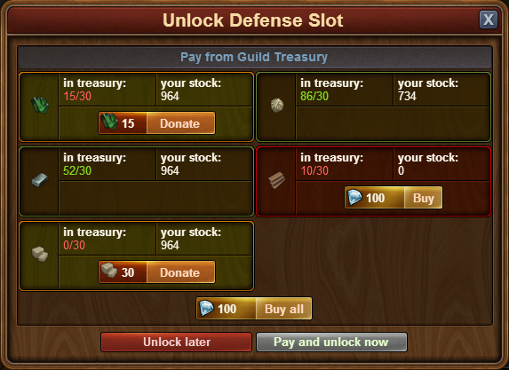
HINT: Granting freedom to a sector your guild no longer wants will also result in goods being paid to your guild's treasury
You can also donate goods to your guild's treasury whenever you feel like it in the Treasury screen.
GvG Terms
Here is a list of GvG-related terms that might be useful to know:
Attack protection - After conquering a sector, it cannot be attacked until the next daily calculation. Also, unless it is a HQ, this sector does not count for placing siege armies and attacking until the next daily calculation.
Average power - The average power of a sector in the province.
Besieged, under siege - A sector that holds a siege army. Besieged sectors do not produce power, and most actions are blocked (like placing a defending army, relocate HQ or grant freedom).
Construction Rebate - According to the level of the guild, all guild members get a discount on the coins and supply costs of their buildings.
Coordinates - A unique identifier for every sector on the province map.
Daily Calculation - At the end of every day, during the daily calculation, power is paid out, and attack protection is lifted.
Defending Army - A sector can hold up to 8 defending armies. If the sector gets attacked, each of these armies has to be defeated 10 times.
Grant Freedom - When a guild “grants freedom” to one of their sectors, it and all defending armies in it will become controlled by an NPC again. The guild will gain a few goods for doing so.
Guild Continent Map - The map in which the provinces are located. Entering GvG will lead you there.
Guild Level - The accumulated power of the maps will contribute to the guild level. Whenever enough points are gathered, the guild levels up and unlocks bonuses for their members.
Guild Ranking - A ranking that displays all guilds sorted by their prestige.
Guild Treasury - The guild treasury holds goods that are contributed by the players and certain events/actions. The treasury is used to pay goods for unlocking slots or placing siege armies.
Guild versus Guild - The official name of the feature is “Guild versus Guild”.
Guild’s area - The sectors controlled by a guild in a province.
GvG / GVG - Abbreviation for “Guild versus Guild”.
Headquarter - The first sector a guild conquers on a map will hold the headquarter. The headquarter can be moved to other sectors. It is important for the distribution of the support bonuses. Also, from a headquarter siege armies can always be placed (there is no 24-hour-protection).
HQ - Abbreviation for headquarter.
Landing Zone - A defined area of sectors in every province in which new guilds entering the map can start and place their initial siege army.
Map Ranking - Every province has a map ranking that displays the guilds sorted according to their daily power.
NPC - “Non-playing character” – if a sector is not controlled by a guild, it is controlled by a NPC instead.
Owner - Either the guild or the NPCs name of whoever owns that sector.
Power - A sector produces power during the daily calculation for the guild that owns the sector.
Prestige - Prestige is calculated from the level of a guild and the daily power. It is used for the global guild ranking.
Prestige Bonus - According to the level of the guild, every day the guild will get a certain amount of prestige.
Province - The guild continent map holds the provinces in which the guilds fight. There is one province for each age, meaning only units and goods from that age are used.
Province’s age - The age of a province; according to our normal ages in the game. In a province, only goods and units from the province’s age can be used.
Recruitment Boost - According to the level of the guild, the recruitment and healing times of units are reduced for all guild members.
Relocate Headquarter - A guild can relocate its headquarter; effectively, the headquarter gets put on to another sector of their territory, as long as neither of the two sectors is under siege.
Research Boost - According to the level of the guild, all guild members receive - Every province holds a large number of sectors. Guilds battle for control of these sectors. A sector provides power.
Siege Army - One member of a guild has to place a siege army on an enemy sector first. Placing a siege army requires goods. Only after placing the siege army the defending armies in that sector can be attacked by members of the guild. Note that the siege army itself does not attack, but it can be attacked and defeated.
Support Bonus - All defending armies in a guild’s sector or a siege army can get a buff. That buff is called “support bonus”. It is calculated from the support pool, the support factor and the distance to the headquarter.
Support Factor - A unique factor for every province; support pool / support factor = total support bonus of that province
Support Pool - All guild members contribute with certain buildings to the guild’s support pool. The support pool and the support factor of a province define the total support bonus for the guild in that province.
Support Pool Bonus - According to the level of the guild, the guild’s support pool is increased.
Unlock - Opening up another slot for a defending army (up to 8 in total). This action requires goods.
Unlocked Slot - A slot that was unlocked and can take a defending army now.
